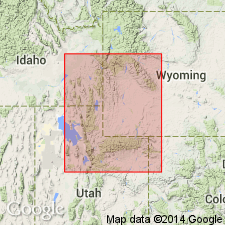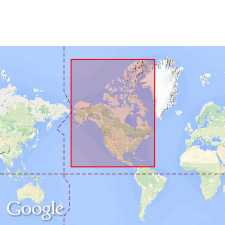
- Usage in publication:
-
- Giraffe Creek Member*
- Modifications:
-
- Named
- Dominant lithology:
-
- Limestone
- Sandstone
- AAPG geologic province:
-
- Green River basin
- Uinta basin
- Snake River basin
- Yellowstone province
- Wasatch uplift
Summary:
Named as upper member of seven members of Twin Creek Limestone for Giraffe Creek about 1 mi east of type section measured on north side Thomas Fork Canyon in NW1/4 SW1/4 sec 20, T28N, R119W, Lincoln Co, WY in Greater Green River basin. Occurs from Jackson Hole, WY (25 ft thick), Yellowstone province west to Willow Creek (295 ft thick), Bonneville Co, ID, Snake River basin and in UT from Lake Fork (200 ft thick), Duchesne Co, UT, Uinta basin west to Burr Fork (200 ft thick), Utah Co on Wasatch uplift. Occurs north of Park City, Summit Co, UT on Uinta uplift and in southwest WY in Greater Green River basin. Is 111 ft thick at type. Rangers from 25 to 295 ft thick. Consists mostly of gray silty to finely sandy ripple-marked, wavy bedded, thin-bedded limestone that is interbedded with gray, glauconitic thin- to thick-bedded sandstone. Thicker limestone beds are oolitic, sandy, and cross-bedded. Some beds are a coquina of crinoid and echinoid fragments. Forms cliffs on ridges. Grades upward into Preuss Sandstone. Overlies Leeds Creek Member (new) of Twin Creek. Fragments of crinoids, echinoids, etc. Short list of fossils. Of middle Callovian, Late Jurassic age. Of shallow to littoral marine origin. Correlates with Hulett Sandstone Member of Sundance Formation, with upper Rierdon and upper Carmel Formations, and upper Twelvemile Canyon Member of Arapien Shale. Correlation chart. Cross sections.
Source: GNU records (USGS DDS-6; Denver GNULEX).

- Usage in publication:
-
- Giraffe Creek Member*
- Modifications:
-
- Overview
- Age modified
- AAPG geologic province:
-
- Snake River basin
- Yellowstone province
- Wasatch uplift
- Uinta basin
- Uinta uplift
Summary:
Is upper member or one of seven members of Twin Creek Limestone. Underlies Preuss Sandstone conformably and overlies Leeds Creek Member of Twin Creek in the Snake River basin, ID, Yellowstone province, WY, Wasatch uplift, Uinta basin, and Uinta uplift, UT. Correlation chart includes information on lithology and thickness as well as showing correlation with part of Sundance, Carmel, and Arapien Formations. Age changed from Late Jurassic (middle Callovian) to Middle Jurassic (early Callovian).
Source: GNU records (USGS DDS-6; Denver GNULEX).
For more information, please contact Nancy Stamm, Geologic Names Committee Secretary.
Asterisk (*) indicates published by U.S. Geological Survey authors.
"No current usage" (†) implies that a name has been abandoned or has fallen into disuse. Former usage and, if known, replacement name given in parentheses ( ).
Slash (/) indicates name conflicts with nomenclatural guidelines (CSN, 1933; ACSN, 1961, 1970; NACSN, 1983, 2005, 2021). May be explained within brackets ([ ]).

